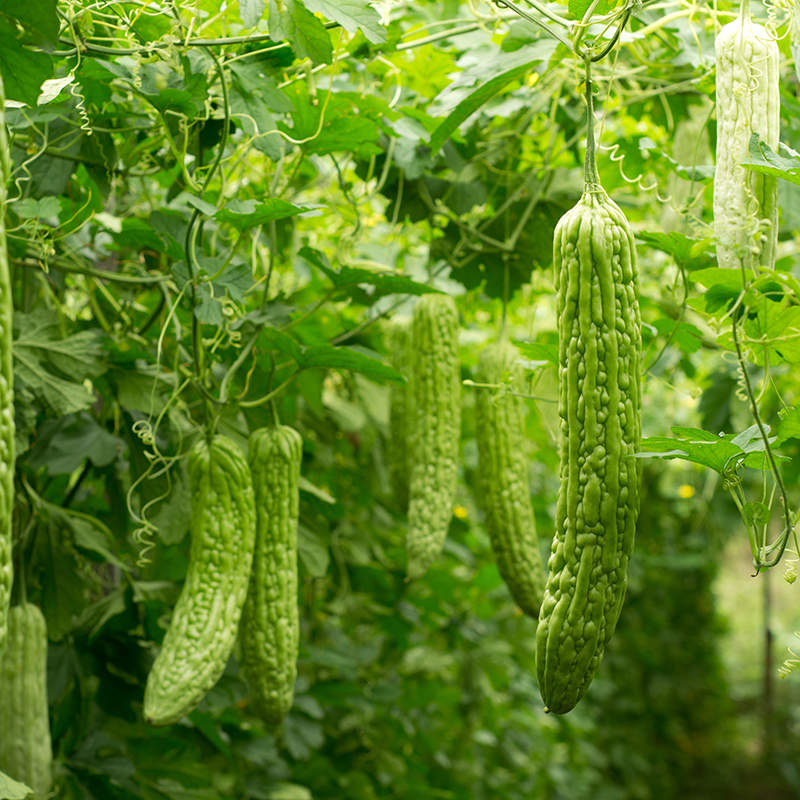Tips on making your fruit the star of the picnic table

Did You Know? For good fruit development, a female watermelon flower needs 500 to 1,000 grains of pollen—and that can take a whopping 21 visits from busy bees.
By June, the melons are off and running—their fat-leafed vines escaping garden beds as orbs of juicy deliciousness grow bigger and bigger. While cantaloupes may be ripe, the honeydew and watermelons you planted back in April probably aren’t yet ready to eat. Study up on growing tips to ensure that your fruit makes it all the way to the picnic table.
Vine Control
“I think people plant melons without understanding how much room, time, and energy they require to actually make fruit,” says Rita Bachmann of Rita’s Roots Backyard Harvest—a company that helps guide home gardeners.
Beginners often do best with cantaloupes, she notes. “They’re easier than watermelons because they tend to be more disease-resistant and mature more quickly. Plus, some varieties grow on a more compact vine.”
The average watermelon, though? A single plant can hog 24 square feet. Just “pick up the vines and direct them where you want them to go, being careful not to crack them,” advises Bachmann. They’ll likely need to trail out of your bed and onto the ground. To prevent rot, don’t allow the fruits to sit directly on soil, instead placing them atop mulch or cardboard.
Water (& Lots of It)
Melons require loads of H2O, and—to avoid splitting—they need it on a consistent basis. Drip irrigation works best, delivering refreshment to the root zone while keeping foliage dry, thus cutting down on disease.
The ideal schedule, according to Joseph Fields—who operates his namesake farm on John’s Island—is to “water in the morning and again in the afternoon or at night.”
For melons, multiple short drinks a day are better than a single long one because their roots don’t grow deep. However, if you don’t have drip irrigation and must water from above, do so in the morning only, so moisture evaporates from the leaves before dark.
Always cut back on watering when fruits are about a week away from harvest—this will concentrate their signature sweet flavors.
Warding Off Problems
The Clemson Cooperative Extension Home and Garden Information Center (hgic.clemson.edu) is a great resource for trouble-shooting. But know that misshapen fruit is often caused by poor pollination. To keep more bees buzzing about, don’t spray insecticides—especially during the prime foraging hours of 8 a.m. to 4 p.m.—and aim to add more native blooms to your landscape.
When to Harvest
Be sure not to slice too soon! Make note of the “days to maturity” listed on the plant tag or seed packet. Most melons bear their first ripe fruit in 70 to 90 days.
Signs a watermelon is ripe:
■ The tendril—what Fields calls the “piggy tail”—closest to the fruit turns brown.
■ The skin goes from glossy to dull.
■ A large white oval appears on the bottom.
■ The melon looks to be about the right size.
Signs a cantaloupe or honeydew melon is ripe:
■ The stem separates completely from the fruit. For some honeydew varieties, there won’t be a full separation, but the skin will become paler in color.
Cool PIcks
Want to spice up your melon crop next year? Try these heirloom varieties. If you can’t find them locally, buy online through specialty seed companies

‘Moon & Stars’ watermelon (Citrullus lanatus)
■ This stunner was loved in the early 1900s, then lost, and finally rediscovered in Missouri in 1980.
■ Capable of growing up to 40 pounds, the melons feature thick, dark green rinds and leaves speckled with yellow spots both large (the moons) and small (the stars).
■ Not just pretty, it’s noted for its sweet, bright red flesh.

Bitter melon (Momordica charantia)
■ Oblong and curiously warty, they grow to about eight inches long.
■ The mouth-puckering fruits mellow with maturity, but melons from the same vine can serve up different doses of bitterness.
■ These fruits work well with fatty or spicy flavor profiles. Often, they’re stuffed with pork or shrimp, pickled, or curried, then dished up alongside meat or in a soup.

‘Charleston Gray’ watermelon (Citrullus lanatus)
■ The variety that Baker Creek Heirloom Seeds calls “one of the best All-American watermelons of all time” originated at Charleston’s own USDA Southern Vegetable Breeders Lab back in 1954.
■ The oblong, grayish-green fruit grows to 25 pounds and larger.
■ Delicious red flesh is touted for its virtually fiber-free quality, while the medium-thick rind is excellent for pickling.
Photographs courtesy of (‘Moon & Stars’) Park Seed Company & (‘Charleston Gray’) Bonnie Plants